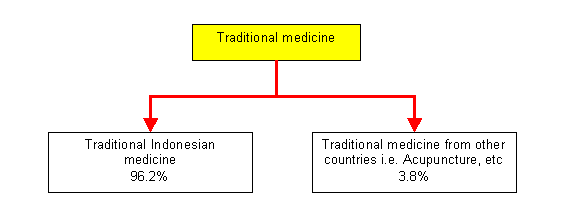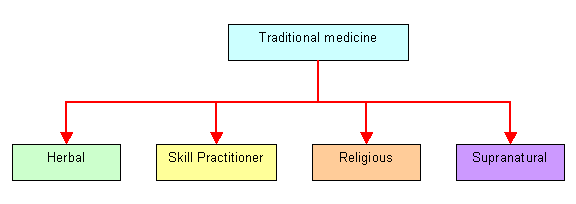Chronological development
- Traditional medical system in Indonesia has many influences from Hinduism, Buddhism and Islam. The oldest and most popular among the traditional medicine practices are herbal medicine ‘Jamu’. It is said that jamu originated from Java.
- Jamu has been used by the Indonesians predated back to the 15th century during Mataram period where historical relics showed pictures of medicinal plants in use on some temples such as Borobudur, Prambanan and Panataran.[1]
- In 1775, medicinal plants (jamu) were studied by the modern science, followed by publication of a book called Herbia Ambionesia by Rumphius[2].
- Colonization of the Dutch in the 19th century brought modern education to Indonesia.
Current practice
Modern (conventional) medicine remains as the mainstream tradition of healthcare in the country. However, traditional medicinal treatments continue to be practiced by numerous healers and practitioners all over the country. It is the means of health maintenance /prevention of illness by the rural people. It is affordable and accessible, especially for the poor and for those living in remote areas, who tend to depend more on traditional and herbal medicines than people living in city.
Prevalence
Ministry of Health conducted a survey in 1995 which reported marked increase in the number of traditional medicine practitioner from 112, 974 practitioners (1990) to 281,492 practitioners (1995) (Table 1). Most of these practitioners used traditional Indonesian method of treatment.

| Traditional Medicine Modalities | Total Practitioners |
|---|---|
| Herbal Medicine Tukang jamu gendong Herbalist | 18,237 14,000 |
| Skill Practitioners Traditional birth attendants Circumcisers Masseuses General traditional medicine Bone setters | 122,944 18,456 25,077 51,383 8,781 |
| Spiritual / Religious Spiritualist | 12,496 |
| Supernatural | 10,118 |
| Total | 281,492 |
In 2001, National Survey of Social Economics shows that, 57.7% of Indonesian society conducted self treatment, 31.7% used traditional drug/ medicine and about 9.8% seek traditional healers [3].
Main therapies
Indonesian traditional medicine can be divided into 4 groups [4]:-

Herbal Medicine
Classified into three categories, namely empirical-based herbal medicine(jamu), scientific-based herbal medicine and clinical-based herbal medicine [5]:
1. Empirical-based herbal medicine
- Prepared traditionally, contains all herbal ingredients
- Divided into regular jamu and standardised jamu
2. Scientific-based herbal medicine
- Prepared from herbal extracts
- Has scientific evidence through pre-clinical studies
3. Clinical-based herbal medicine
- Equal to modern medicine
- Has scientific evidence which is supported by clinical test on human subjects.
Skilled practitioners
Consist of traditional birth attendants, circumcisers, masseuses, general traditional medicine and bone setters.
Policy & Regulations
In early 1990s, the Indonesian Ministry of Health has adopted a policy for the modernisation of traditional medicines and in the year 2000 a decree was drafted to integrate traditional medicine into modern medicine while retaining its identity.
It encompasses several aspects, such as diagnosis through the use of modern techniques while providing treatment by traditional methods, as well as modernization of the production processes and quality control of traditional medicines.
Facilities
Not Documented.
Insurance coverage
Not Documented.
Research Institute/s
- National Agency of Food and Drug Control (NAFDC)
- Indonesian Institute of Sciences (LIPI)
- Badan Pengajian dan Penerapan Teknologi (BPPT)
- National Institute of Health Research and Development (NIHRD)
Training & Education
There are a few formal types of education pertaining to the traditional medicine programme under Ministry of Health and Social Welfare.
There are:
- School of Acupuncture within the School of Medicine, University of Indonesia. It offers a Masters programme.
- Academy of Acupuncture: entry criteria is high school graduates. It is a 3-year programme.
- School of Traditional Medicine Technical Production Programme at Gajah Mada University which offers a diploma course/programme.
References
- WHO global atlas of traditional, complementary and Alternative medicine; Text volume :chapter 13 pg 97-101; G.Bodeker; C.K Ong; C. Grundy; g. Burford; K. Shein
- Protection of Traditional Knowledge in Indonesia: Review; Prof. Dr. Ir Sulaeman Kamil; UNCTAD Expert Meeting on Systems and National Experiences for Protecting Traditional Knowledge, Innovations and Practices; Geneva, 2000.
- WHO global atlas of traditional, complementary and Alternative medicine; Text volume :chapter 13 pg 97-101; G.Bodeker; C.K Ong; C. Grundy; g. Burford; K. Shein
- Protection of Traditional Knowledge in Indonesia: Review; Prof. Dr. Ir Sulaeman Kamil; UNCTAD Expert Meeting on Systems and National Experiences for Protecting Traditional Knowledge, Innovations and Practices; Geneva, 2000.
- Traditional and Complementary Medicine: Indonesia Country Report; ASEAN Working Group Meeting on Traditional and Complementary Medicine; Penang, Malaysia April 2004.
- Legal Status of Traditional Medicine and Complementary/ Alternative Medicine: A Worldwide Review, WHO 2001; pg134-135.
- Introduction – Traditional Herbal medicine; Sipuk Bank Indonesia [ website : http://www.bi.go.id/sipuk/en/jamu_tradisional/pendahuluan.asp] Accessed on 20 Jun 2007


